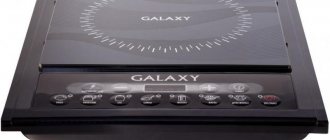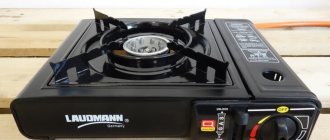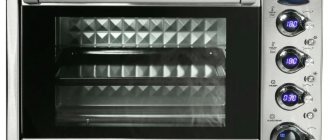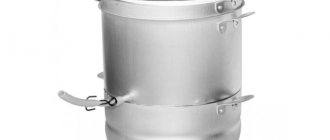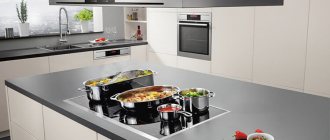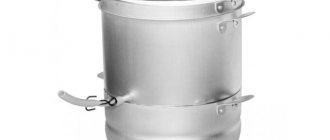Types of hobs: which one is more economical
If the house has a gas pipe, most often a gas or combined panel is installed, and this is understandable - gas is much cheaper than electricity, and the surface itself will cost you less. A standard combined surface usually includes 3 gas points and one electric. Frankly, gas hotspots have a number of disadvantages.
This:
- Fire hazard - open fire can lead to the most disastrous consequences;
- There is a problem with moving the stove to another location; coordination with gas services will be required;
- The difficulty of carrying out repairs is that only specialized city gas services have the right to repair gas stoves.
In view of this, electric hobs are becoming increasingly popular and have good reviews. Their list of advantages includes greater functionality and ease of use. If you have chosen them, you should decide on the surface material: enamel coating, aluminum, stainless steel or glass ceramics.
The electric hob is becoming more and more popular every day.
The first three coating options are inexpensive materials, which have mainly low cost and a number of disadvantages as advantages. However, they can still be found in the kitchen of many homes.
Glass ceramics are becoming increasingly popular due to their beauty and versatile style. It is quite easy to clean, but at the same time you will have to always be on alert with it. Do not use abrasive substances or use the hard side of the sponge to avoid scratches. Glass ceramics is the most expensive type of material for a hob, however, sales of such a panel exceed the sales of all other options. There are 2 main types of glass-ceramic stoves: electric and induction.
Peculiarities
The functioning of infrared cookers is ensured by heating elements. With their help, infrared radiation is created through the glass-ceramic work surface. It is absorbed by the water in the food. As a result, a lot of heat is generated, causing the stove to become hot after some time. With the help of such devices, food is prepared in the shortest possible time.
Glass-ceramic materials are used as working surfaces in infrared cookers, which have a large number of advantages. They conduct heat well and are very resistant to high temperatures. Another important advantage of infrared cookers is their high heating rate. It is also worth noting that you can easily set the optimal temperature (from minimum to maximum high).
Glass-ceramic worktops are very easy to use and clean, and they are also highly durable. They can be used to create a wide variety of dishes. Infrared cookers are especially often used for preparing baked goods, various fish and meat dishes.
Infrared cookers can be placed on a table or on the floor. Some devices have an oven. Infrared cookers have several burners: from 2 to 4. Tabletop appliances are compact, lightweight, and mobile. A portable infrared stove can be used as a tourist or camping stove.
The difference between an induction hob and an electric one: comparison
In fact, both induction and electric cooktops are electric. An induction cooker is a more advanced model of the basic electric cooker, which has a number of features. So, induction cookers, unlike electric ones, have the following important differences.
Induction hobs are completely safe
Positive:
- The surface of the stove does not heat up, which is very important if there are children in the house, they cannot get burned;
- Safety - if there are no special dishes on the stove, the stove will not turn on, it only heats the dishes placed on it, without heating itself;
- Accordingly, less electricity is consumed, saving money;
- Very fast heating of food, many times faster than on a conventional electric stove - water boils within 2-3 minutes.
Negative differences between an induction cooker and an electric one: during operation you can hear a slight noise from the fan located inside the panel, high price. Cannot be used with ordinary dishes - you must purchase dishes (pots, frying pans) with a special magnetic coating on the bottom.
Which is better
only heats that is placed on it, and it must be of the right type. It works more economically . An infrared stove heats everything that is on it, and even the air if you forget to place the dishes.
If a person needs an economical stove and is not intimidated by the fact that he will have to buy suitable cookware for it, an induction unit will be an excellent choice for him. If it needs dynamic heating and cooking, infrared options will be more relevant.
When choosing a specific model, you should focus primarily on the manufacturer , and it is better if it is well-known. It is also worth considering certain modifications based on your own needs: the number of burners, current options, type of control, presence of a timer and self-cleaning technology, maximum heating rate, body material.
Electronics and technologyComment
Which is better: induction or electric hob
We looked at the important distinguishing features of the two panels. The principle of operation of an electric stove is clear to everyone - the electric current interacts with the heating elements located under the glass-ceramic coating and heats the dishes standing accordingly. In this case, spirals made of a special metal are used as heating elements. Control can be carried out either mechanically or using a sensor.
What is the secret of an induction hob? Its operating principle is completely different from the operation of basic electric stoves. It does not have heating elements in the form of metal plates; such panels use electromagnetic coils, which, when electricity is supplied, creates a magnetic field around itself.
On the hob, cookware with a special magnetic bottom heats up very quickly
If a dish with a special magnetic bottom is placed on the surface, it will heat up very quickly.
Such a heating system will not even pay attention to ordinary dishes. At the same time, during rapid heating of the dishes, the surface of the stove will not heat up. Due to the fact that the stove begins to consume electricity only when the dishes are standing and only for the size of the bottom of the cookware - and not for the entire area of the cooking zone - the energy savings are quite significant - the consumption is 1.5 times lower than that of a conventional electric stove. At the same time, it is worth noting that the price of an induction surface significantly exceeds the level that an electric stove holds. Therefore, if you do not plan to cook a lot, the savings from reducing energy consumption are doubtful. It is up to each owner to choose which is better - induction or electric hobs, based on what exactly he needs.
Comparison and how they differ
Pros of an infrared cooker:
- The equipment does not consume much electricity if you heat the dish at a temperature of 60 degrees .
- After cooking is completed, the sensor lights up, indicating that the device has not yet cooled down.
- It does not take much time to prepare a dish compared to a gas stove.
- You can use the option to reduce the surface temperature at any time.
- Power level adjustment is available.
- Even a heavily soiled work surface can be easily washed.
- To control the cooking process, the stove is equipped with a monitor and timer.
- There are no harmful factors such as soot and carbon monoxide.
- There is protection against accidental changes and power surges.
- Any utensil except plastic, plastic and paper can be used.
Disadvantages of an infrared cooker:
- The glass-ceramic surface is very fragile and may be damaged during transportation. In this case, it cannot be repaired and requires complete replacement.
- If water is spilled on the device, it may impair its functionality. When it hits the surface, an unpleasant cracking sound occurs.
Pros of an induction cooker:
- Electricity is consumed 1.5 times less compared to an electric stove.
- After removing the cookware from the surface, the induction cooker turns off and cools down, which minimizes burns when touching the surface. There will also be no need to set aside a frying pan or pan if a recipe calls for it to be removed from the heat.
- The stove is easy to use and easy to care for after cooking due to the fact that the surface will not be hot. This advantage eliminates the formation of burnt food residues on it.
- The process of cooking and heating food is 3 times faster .
- There are several cooking modes that will allow you to use it for certain purposes. For example, you can slowly stew vegetables or quickly boil water.
- The appearance attracts attention.
- The burners have a smooth surface , they are easy to use, and it is easy to move any utensils on them.
Induction or electric hob: the difference between them
Regardless of which of the surface models discussed above you choose, it is worth knowing that both of them most often have a glass-ceramic coating. This coating looks very stylish and beautiful and does not spoil the interior even in a kitchen studio. But it is important to use such a surface correctly.
It cannot be cleaned with powder products - the glass ceramics may be scratched.
The glass-ceramic coating of the hob looks very impressive, but it must be properly cared for
You need to be careful when operating - do not throw devices, do not knock on it. With an electric stove, you must try to avoid burning food on the surface - since the washing process is quite a labor-intensive task. In this case, there are no such problems with induction cookers, since the surface is always cold and any spills of food or liquid on it can be easily wiped off with a damp sponge.
Both stoves have a large number of programs: child protection (locking buttons), heating adjustment, changing the size of the heating area in the case of an electric stove. The noise level when operating an induction cooker is higher than when operating a conventional electric cooker. Or rather, an electric hob has no noise at all. Induction is equipped with a fan that cools the stove and the sound of its operation is slightly audible.
Pros of IR cooker
- Economical . The device consumes relatively little electricity, which reduces electricity bills.
- Cooking time is reduced due to the rapid heating of the glass-ceramic surface, as well as high heat transfer during the cooking process due to the absorption of infrared radiation by the products.
- Operation does not require the use of special utensils .
- Easy to care for . The glass ceramic surface can be easily and quickly cleaned of dirt.
- Safety . During cooking there is no carbon monoxide or open fire, unlike gas stoves.
- Quick temperature reduction function (unlike an electric stove).
- Many models are equipped with several heating power levels (maximum 10). This is very convenient, because the stove can be used instead of a microwave oven by setting the heat to 60°C. This will consume a minimum amount of electricity.
- Many models are equipped with a display and an electronic timer . Also on sale are models with a child safety feature and a self-cleaning system.
- Infrared cookers are equipped with a residual heat indicator , which glows until the cooker has cooled down after use. This feature provides protection against accidental burns.
- There is built-in protection against overheating and power surges , which allows you to extend the life of the equipment.
- Tabletop models of stoves take up little space, so they are convenient for transportation and are perfect for use in the country.
Unique infrared hob
Perhaps the third common type of electric stove is the infrared stove. These hobs are also equipped with a glass-ceramic surface. Heating occurs through an electric current that heats the heating elements, which in turn create infrared radiation.
You can use absolutely any utensil for the infrared cooker.
Water, which is part of all products, absorbs this radiation and thereby releases heat, which heats the stove.
Due to its good thermal conductivity, such a stove quickly heats up to the desired temperature. You can cook absolutely any food on such surfaces – from cheesecakes to borscht. This stove can be used with any type of cookware, except for paper or plastic.
How to choose and use correctly
When choosing an infrared cooker, it is important to consider a well-known manufacturer; you can read reviews about the manufacturers you are interested in in advance; as for the model, it all depends on individual preferences. Main criteria: number of burners, heating temperature, presence of additional functions (timer, display, child lock function, etc.)
It is recommended to wash the device with a cleaner for glass-ceramic surfaces without using abrasives, as they can scratch the surface.
Criteria: what is the difference between an induction hob and an electric one (video)
In this article, we looked at the main options for hobs, helped us compare and choose. However, which model to choose is always up to the buyer. Each of the models has a set of both advantages and disadvantages.
Similar articles
- Induction hob: pros and cons, secrets of choice
A modern kitchen is not an easy place to prepare food, but also original design solutions that combine beauty and a large amount of... - Fiber cement panels for exterior home decoration
A beautiful facade of a house is the finishing touch in its construction or restoration. Since more and more materials are appearing for its cladding, keep track of... - How to choose a convector: electric for heating, which one is better for an apartment, the right one for a house, power
You can quickly and easily heat a room using a high-quality convector. In the cool season, residents of private houses and apartments are faced with the question...
Best models
Some models of infrared devices are especially popular among consumers. They are distinguished by high quality and good performance characteristics. Let's look at some of them.
- Irida-22. This stove can be used in a country house, on a hike, and is a tabletop stove. Irida-22 is a two-burner stove, the power of the burners can be adjusted. The device operates using liquid gas contained in a cylinder. It is completely burned. The Irida-22 model is made of metal. The wind does not extinguish the flame of this stove, so it is very suitable for outdoor use.
- BW-1012. In addition to cooking, such a stove can be used to heat a room. It can be used in a country house, in an apartment, or on a hike. The burner of this infrared stove is ceramic; it does not emit any unpleasant odor or substances harmful to humans. One of the main advantages of this model is the ability to regulate the fire in the burner. It is distinguished by its reliability and long service life.
- Electrolux Libero DIC2 602077. Electric two-burner stove with glass-ceramic work surface. The electric stove is easily controlled using a digital display. This model is very often used in various cafes with average traffic, small restaurants, and catering establishments.
- CB55. This model can be used for heating while traveling and for cooking. It is suitable for use in summer kitchens and country houses. The burner is ceramic. Propane burns out completely, so it is used as economically as possible. The strength of the fire in the burner is smoothly adjustable; the device has piezo ignition. This model works well even in strong gusts of wind, and its body is made of steel coated with heat-resistant paint and varnish.
OUR SITE RECOMMENDS:
Why do you need a cam module on a TV?
15.12.20190
Contents1 What is a CAM module2 Types of cam modules3...
Output to TV from Samsung phone
15.12.20190
Contents1 Ways to connect to Smart TV Samsung2 Application...
Free statistics for the site
15.12.20190
A year ago we implemented a HotLog counter for sites...
Games started to slow down on the computer
15.12.20190
Windows 10 users have noticed a significant drop in graphics performance...
The last notes
How to recover Instagram page without email
15.12.2019 0
How to restore a VK page without a last name
15.12.2019 0
How to restore a VK page if the number is lost
15.12.2019 0
How to restore a column in Excel
15.12.2019 0
Which stove is better - electric or induction?
Choosing a hob is one of those issues that both happy new residents and simply those whose old stove has become unusable have to decide.
Today, the choice is usually made between electric and induction hobs: gas stoves are also good in their own way, but many new buildings now don’t even have gas installed.
And this choice, for all its inevitability, is not too obvious. So which stove is better - electric or induction?..
I have long planned to write an article about the pros and cons of electric and induction hobs, but I wanted to do it from a practical point of view, which I now have every right to: for six years I cooked on an electric stove, which I recently replaced with an induction hob Pyramida IFEA 640 B, and now I can tell you about the advantages and disadvantages of both solutions from my own experience.
How is an induction cooker different from an electric cooker?
Before answering the question of which stove is better - induction or electric - let’s figure out how they differ. Let's start with electric hobs as the older ones.
Their principle of operation is quite simple: electric current passes through a resistor, which releases thermal energy, which, in turn, is transferred to the dishes placed on the heating element.
Modern electric stoves mainly have a surface made of glass ceramics, but in terms of their design they are not so far removed from the old electric stoves with metal burners.
An induction hob operates differently: under each burner there is a high-frequency generator that creates eddy induction currents in the metal cookware placed on the burner.
In this case, the cookware acts as a conductor, and it is it that heats up, and not the coil or the surface of the stove - provided that the cookware has conductive properties.
If all this doesn’t sound very clear to you, don’t worry about theory, let’s better find out what this means for us in practice.
So, let's compare induction and electric cookers on various parameters and then come up with the final score. For each indicator, both types of slabs will be awarded from 0 to 2 points, depending on how well they perform in one aspect or another.
Suitable cookware
The first thing I did when I became the proud owner of an induction cooker was to go to the store and buy an adapter, this steel pancake, which costs much more than you might expect by looking at its shape.
As mentioned above, an induction cooker is capable of heating only cookware that has ferromagnetic properties, of which there were surprisingly few of the pans and pots that served me faithfully.
The adapter is capable of turning an induction cooker into a regular electric one, heating up and transferring its heat to the cookware placed on it, but it deprives it of all the advantages that will be discussed below. If you place the wrong frying pan on the induction burner, it won’t even turn on.
To understand whether a cookware is suitable for an induction cooker, attach a magnet to it or simply turn it over; the following pictogram is usually placed on compatible cookware:
At first glance, electric stoves do not have this drawback, but in practice they are far from ideal.
An electric hob can only provide even heating if the cookware has a perfectly flat bottom, but even the most reliable pot or pan will warp over the years when exposed to intense heat.
For the same reason, it is inconvenient or simply impossible to cook on an electric stove, using a regular wok or cauldron with rounded walls and bottom, you will have to use utensils adapted specifically for electric hobs.
Induction hob – 0 points Electric hob – 1 point
Ease of use
The virtue you will need when using an electric stove is patience. The burner heats up quite quickly, almost instantly, but it takes time to transfer its heat to the cookware. A lot of time. It takes about 7 minutes to heat a frying pan to a temperature suitable for frying, and 15-20 minutes to bring a pot of water to a boil for pasta.
In order to change the temperature of already heated dishes, everything is also not easy - quickly increasing the “fire” from low to maximum simply will not work, and the most reliable way to quickly reduce the heat is to remove the dishes from the stove. Perhaps this is the most important disadvantage of an electric hob - it is slow, inert, and this makes it terribly inconvenient.
This is not the case with an induction hob. The source of heat in its case is the bottom of the cookware itself, so the increase or decrease in heating occurs literally instantly: if your previous stove was gas, you won’t even notice the difference.
I specifically conducted an experiment and recorded the time it took my Pyramida IFEA 640 B to bring 2 liters of water to a boil in a saucepan without a lid. It took 9.5 minutes - more than half as much time as I would have spent using an electric stove. In addition, the induction hob has other advantages arising from its operating principle.
Firstly, it is high efficiency - thermal energy does not go “into the air”, but is almost completely used to heat food.
Secondly, its efficiency - since almost all the energy is used for its intended purpose, an induction cooker, all other things being equal, consumes less electricity and costs you less. Considering that electric and induction hobs cost approximately the same, this is an extremely useful feature in these times.
Thirdly, the stove will automatically turn off if you remove the dishes from the burner, which also helps to save both natural resources and your money. In general, in terms of convenience, the induction hob deserves a solid five (which on our scale corresponds to a solid two).
Induction hob – 2 points Electric hob – 0 points
Noise
During its operation, the induction hob makes various sounds, which was a discovery for me, because the electric stove is absolutely silent. This cannot be said about induction; it crackles quietly, turns on a fan hidden in its depths to cool the coil and the transistor radiator, in a word, it lives its own life.
Do not in any way think that these sounds irritate, frighten or somehow interfere with my life, but they exist, and after the electric stove has not made the slightest sound for several years, this is surprising. To the credit of the induction cooker, I can assure you that these sounds are quite quiet, and you stop noticing them quite quickly.
Induction hob – 1 point Electric hob – 2 points
Heating the hob
The operating principle of an electric stove is that heat is transferred to the cookware by contact with a heated burner. In other words, an electric stove simply must be hot, heat up quickly and not cool down too quickly, which entails several not very pleasant consequences.
Firstly, such a stove poses a risk of burns, especially for children and pets, and also, albeit a moderate, but still a fire safety threat.
Secondly, as the stove cools down, it releases residual heat into the surrounding air, and if it happens in the hot summer, and you also don’t have air conditioning, you can imagine what an inferno the kitchen turns into when preparing several dishes at the same time.
Thirdly, any liquid, like sauce or soup, when dropped onto a heated burner, instantly turns into acrid smoke, leaving a hard-to-remove black stain on the surface. Of course, there is a wide selection of products on sale to combat such pollution, but the very fact of the appearance of unpleasant odors and additional headaches cannot be encouraging.
An induction hob is a different matter! As mentioned above, it does not heat itself, but generates heat directly in the cookware placed on it - and this alone creates a huge gap between electric and induction cookers.
Yes, an induction hob can get hot, but this will be from the heat of the cookware placed on it, and if you remove the pan from the stove, the hob will quickly cool down. There will be no burns, there will be no overheating of the air, and stains, if any, will be wiped off with much less difficulty.
In short, in terms of this parameter, an induction cooker is ahead of an electric cooker by a large margin.
Induction hob – 2 points Electric hob – 0 points
Verdict
Of course, I haven’t listed all the differences between induction and electric stoves, but I’ve listed the most basic ones, so it’s time to summarize. Let's calculate the points scored:
Induction hob – 5/8 Electric hob – 3/8
What does this mean? The fact that an electric hob is quite suitable for use, which I have proven from my own experience, and you can check for yourself, because 99% of the recipes from this site over the past 6 years have been prepared on an electric stove.
In turn, an induction cooker cannot be called ideal either - and if you can turn a blind eye to such a trifle as a little noise, then the incompatibility with a large number of otherwise good cookware is much more saddening. This means that technology has room to grow, and we can hope to see hobs and stoves without these shortcomings in the foreseeable future.
However, at the moment, an induction cooker is a thing of today, and an electric cooker is already yesterday. Does this mean that an induction cooker is definitely better than an electric one? I think I’m ready to answer this question in the affirmative, because the advantages of my new Pyramida stove outweigh its disadvantages, and there is no shortage of cookware suitable for induction stoves.
For those who managed to acquire their favorite cookware and do not want to send it to the dustbin of history along with the old stove, there are quite working solutions - the already mentioned adapter for induction cookers or combined hobs, some of the burners of which are conventional electric, and the rest work on induction principle. This will allow you not to part with your favorite dishes, but at the same time open the door to the future - since you are still afraid to open it wide open.
Source: https://arborio.ru/varochnaya-panel-elektricheskaya-ili-indukcionnaya/
Infrared or induction cooker: comparison and which is better to choose – Website about
Infrared cookers are very popular among Russian consumers. Many of these models are universal: they can be used both for cooking and for heating rooms. Let's consider the characteristics and features of infrared cookers, recommendations for their use, as well as their main differences from induction devices.
The functioning of infrared cookers is ensured by heating elements. With their help, infrared radiation is created through the glass-ceramic work surface. It is absorbed by the water in the food.
As a result, a lot of heat is generated, causing the stove to become hot after some time. With the help of such devices, food is prepared in the shortest possible time.
Glass-ceramic materials are used as working surfaces in infrared cookers, which have a large number of advantages.
They conduct heat well and are very resistant to high temperatures. Another important advantage of infrared cookers is their high heating rate.
It is also worth noting that you can easily set the optimal temperature (from minimum to maximum high).
Glass-ceramic worktops are very easy to use and clean, and they are also highly durable. They can be used to create a wide variety of dishes. Infrared cookers are especially often used for preparing baked goods, various fish and meat dishes.
Infrared cookers can be placed on a table or on the floor. Some devices have an oven. Infrared cookers have several burners: from 2 to 4. Tabletop appliances are compact, lightweight, and mobile. A portable infrared stove can be used as a tourist or camping stove.
The surface of the device is covered with enamel, glass ceramics or made of metal (stainless steel). Metal models are characterized by increased resistance to mechanical stress, while glass-ceramic models are more resistant to temperature fluctuations. Enamel also has the above advantages, but at the same time it is also quite affordable.
Induction cookers operate using electromagnetic coils. When electricity is supplied, a magnetic field is created around them. Such stoves heat only special dishes (usual ones should not be used for such devices), while infrared stoves heat everything around: the surface of the device, the composition of the food and the air.
When deciding which infrared cooker to purchase, you should first decide on the size of the device. It depends on how much food will need to be prepared, as well as how large or small the room will be.
It is better to purchase an appliance that includes an oven: in this case, you do not have to install the oven separately, and you can also save space in the kitchen.
Cookers with an oven are more expensive, but they have significantly more advantages.
The cost of infrared devices also depends on the material from which they are made. Metal devices are more expensive.
It is worth paying attention to the presence of various additional functions: built-in dirt removal, residual heat indicator, timer. Such functions will reduce the cooking time.
Glass-ceramic surfaces are resistant to temperature changes and are quite durable. However, such surfaces cannot be repaired, so if damaged, they must be completely replaced. If necessary, heating elements that emit infrared radiation can also be replaced with new ones, but it is better to entrust such work to experienced professionals.
When using an infrared device, it is better to take into account some recommendations. For example, you should be very careful when heating the device to high temperatures.
Some experts believe that radiation from infrared devices is not safe for the human body.
To reduce the risk of undesirable consequences, you should load the surface of the device in use to the maximum.
After finishing cooking, immediately turn off the stove (each section should be turned off). Avoid getting water on the stove, otherwise you may damage the device or get burned.
Some models of infrared devices are especially popular among consumers. They are distinguished by high quality and good performance characteristics. Let's look at some of them.
- Irida-22. This stove can be used in a country house, on a hike, and is a tabletop stove. Irida-22 is a two-burner stove, the power of the burners can be adjusted. The device operates using liquid gas contained in a cylinder. It is completely burned. The Irida-22 model is made of metal. The wind does not extinguish the flame of this stove, so it is very suitable for outdoor use.
- BW-1012. In addition to cooking, such a stove can be used to heat a room. It can be used in a country house, in an apartment, or on a hike. The burner of this infrared stove is ceramic; it does not emit any unpleasant odor or substances harmful to humans. One of the main advantages of this model is the ability to regulate the fire in the burner. It is distinguished by its reliability and long service life.
- Electrolux Libero DIC2 602077. Electric two-burner stove with glass-ceramic work surface. The electric stove is easily controlled using a digital display. This model is very often used in various cafes with average traffic, small restaurants, and catering establishments.
- CB55. This model can be used for heating while traveling and for cooking. It is suitable for use in summer kitchens and country houses. The burner is ceramic. Propane burns out completely, so it is used as economically as possible. The strength of the fire in the burner is smoothly adjustable; the device has piezo ignition. This model works well even in strong gusts of wind, and its body is made of steel coated with heat-resistant paint and varnish.
See the video below for testing the infrared cooker.
Source:
Which stove is better - electric or induction?
Choosing a hob is one of those issues that both happy new residents and simply those whose old stove has become unusable have to decide.
Today, the choice is usually made between electric and induction hobs: gas stoves are also good in their own way, but many new buildings now don’t even have gas installed.
And this choice, for all its inevitability, is not too obvious. So which stove is better - electric or induction?..
I have long planned to write an article about the pros and cons of electric and induction hobs, but I wanted to do it from a practical point of view, which I now have every right to: for six years I cooked on an electric stove, which I recently replaced with an induction hob Pyramida IFEA 640 B, and now I can tell you about the advantages and disadvantages of both solutions from my own experience.

